
Humpback whales (Megaptera novaeangliae), a mysticete with a cosmopolitan distribution, demonstrate marked behavioural plasticity. Recent studies show evidence of social learning in the transmission of specific population level traits ranging from complex singing to stereotyped prey capturing behaviour. Humpback whales have been observed to employ group foraging techniques, however details on how individuals coordinate behaviour in these groups is challenging to obtain. This study investigates the role of a novel broadband patterned pulsed sound produced by humpback whales engaged in bottom-feeding behaviours, referred to here as a ‘paired burst’ sound. Data collected from 56 archival acoustic tag deployments were investigated to determine the functional significance of these signals. Paired burst sound production was associated exclusively with bottom feeding under low-light conditions, predominantly with evidence of associated conspecifics nearby suggesting that the sound likely serves either as a communicative signal to conspecifics, a signal to affect prey behaviour, or possibly both. This study provides additional evidence for individual variation and phenotypic plasticity of foraging behaviours in humpback whales and provides important evidence for the use of acoustic signals among foraging individuals in this species.

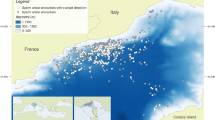
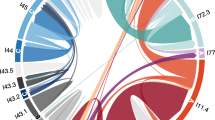
Why animals choose to cooperate, with animals from their own or other species, has long been a puzzle to evolutionary biologists 1,2,3 . More recently, these behaviours are increasingly being viewed as evidence of higher-level cognitive complexity in a wide variety of animal species 4 . Cooperative behaviours, particularly those associated with foraging, have been described in a wide diversity of taxonomic groups ranging from fish and reptiles 5 , to higher order mammalian groups including primates, carnivores, elephants and cetaceans 6,7,8,9 .
Research on cooperative behaviour and learning in cetaceans has focused extensively on the odontocetes (toothed whales) 10 . Much less attention has been given to cooperative behaviours and learning in mysticetes, the larger baleen whales 11 . This may be due to the apparently simple social interactions of many baleen whales and the logistical challenges of observing their behaviours in the open ocean. However, one species of baleen whale, the humpback whale (Megaptera novaeangliae), has a social system with characteristics that are similar to those in complex fission-fusion societies in odontocetes 12 .
Humpback whales show marked behavioural phenotypic plasticity in acoustic communication and social structuring. Humpback whale song, which varies between populations and changes annually, has provided some of the earliest evidence of behavioural plasticity and acoustic social learning in this species on the breeding grounds 13,14,15 . The social structure of humpback whales on their feeding grounds varies from solitary individuals to stable short-term associations between both kin and non-kin 16,17 and behavioural studies of humpback whales have revealed rapid cultural transmission of acoustic repertoire and social learning contributing to the spread of novel foraging behaviours within a population 15,18,19 .
Humpback whales also show extensive variation in foraging behaviours, ranging from solitary surface and bottom feeding to highly coordinated and apparently cooperative group feeding behaviours 20,21,22 . Feeding strategy varies by prey type and individuals also show distinctive individual variation within specific feeding strategies 21,23,24 . In Alaska, large groups of surface lunge-feeding humpback whales use tonal acoustic cues to synchronize lunge feeding behaviours 22,25,26 . These coordinating feeding sounds have not been detected during group feeding in any other humpback whale populations, possibly due to differences in prey type, prey behaviour and habitat characteristics.
This study used digital acoustic and multi-sensor recording tags to describe a novel acoustic signal produced during bottom feeding behaviours by humpback whales in the Northwest Atlantic. Previous studies using tag data have revealed multiple foraging strategies of individuals including diel trends in diving behaviour, likely driven by prey behaviour 21,23 . A study of tag data collected from associated pairs of humpback whales demonstrated that whales in this population often feed on the seafloor in close coordination, showing tight synchrony in diving and bottom behaviours 27 . A previously undescribed sound type, the paired burst 28 , was detected in the acoustic record of tags from the same dataset. The behavioural function of this sound is unknown. It is similar in structure to the humpback ‘megapclick’ 29 , however it is lower in amplitude, has a rhythmic alternating ‘tick-tock’ quality and lacks the variable inter-pulse interval that characterizes the ‘megapclick’. Here we describe the occurrence of paired bursts to assess their potential function, either as a communicative signal to conspecifics, a signal to affect prey behaviour, or both.
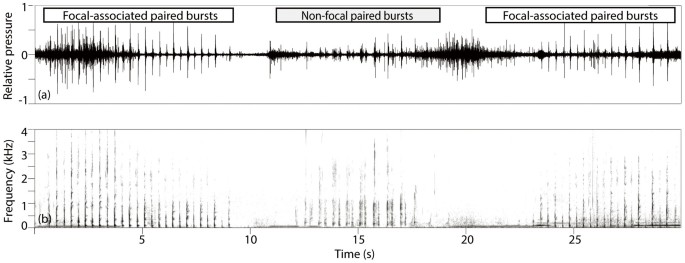
Of the 56 tags analysed, 25 tags showed evidence of bottom feeding dives. Paired burst bouts were commonly found on tags with evidence of bottom feeding dives (18/25 tags) and not found on any tags without bottom feeding dives (0/31 tags). All dives containing focal-associated paired burst sound production were flat-bottom dives with rolling behaviours or digging into the substrate, consistent with bottom foraging behaviour 23,27 (Figure 2) (Supplementary Table S1). The timing of bottom feeding behaviours by the tagged whale were tightly synchronized with the end time of paired burst bouts, both for focal-associated paired burst bouts (Figure 2) and during louder non-focal associated paired bouts (Figure 3, non-focal paired burst bouts were >15 dB but
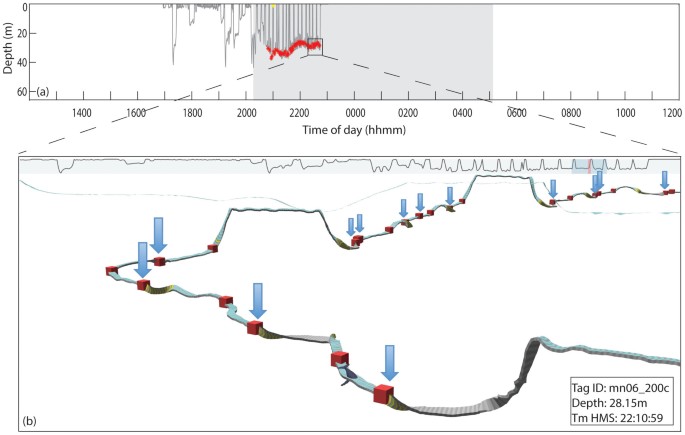
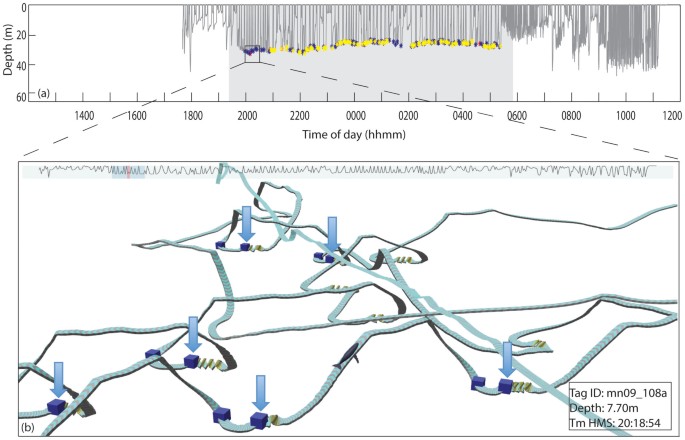
Most of the whales (11/15) with focal-associated paired bursts were tagged on Stellwagen Bank over several years. The remaining four whales were tagged about 50 km east of Chatham, Massachusetts in 2004. Stellwagen Bank is on average only 30–35 m deep and the 2004 tagging area is more than twice the depth at an average of 78 m. Almost all (99%) paired burst bouts from the focal-associated bouts were detected at night for tags attached on Stellwagen Bank (n = 11 tags). The other 1% occurred during dusk hours (Figure 4). In the deeper tagging location east of Chatham in 2004, where bottom light levels would be expected to be less than 1% of the surface light levels 30 , tagged whales engaged in bottom feeding during all periods of the day but only 68% of paired burst bouts were produced at night and 32% produced during daylight hours (n = 4 tags).
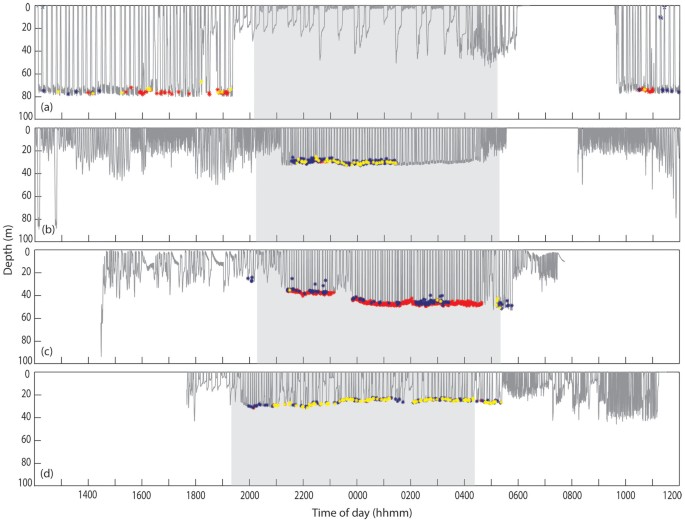
We identified two tag records with repeated sequences of very faint paired burst bouts that increased in received level (RL) on the tag as the whale dived toward the bottom (Figure 5), indicating that the signalling whale either increased signal amplitude as it approached the bottom of its dive, or, more likely, was approaching a conspecific that was producing paired bursts near the bottom.
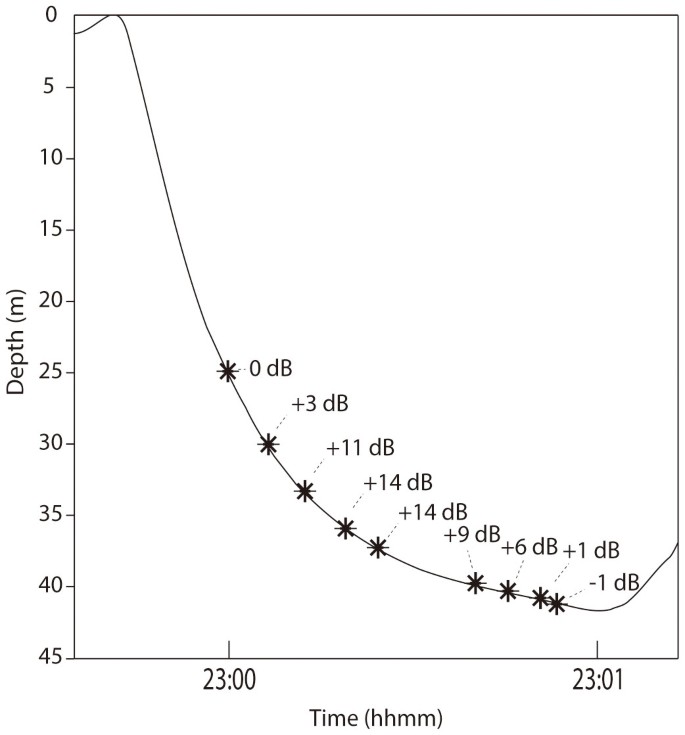
For whales with focal-associated paired burst bouts during bottom feeding dives, the majority (12/15) showed evidence of another humpback whale nearby on 100% of their bottom feeding dives containing paired burst bouts (Table 1). The 3 tagged whales that did not have 100% evidence of a nearby conspecific during paired burst dives were closely associated with other humpbacks during their dives based on our conservative criteria ≥73% of the time. All individuals that made bottom feeding dives containing focal-associated paired burst bouts also made very similar bottom foraging dives with no detectable paired bursts. On average, only 60% of bottom feeding dives without paired burst bouts showed evidence of nearby conspecifics, compared to an average value of 97% of bottom feeding dives with paired bursts. Frequently it was bottom feeding dives that occurred during daylight hours that showed evidence of conspecifics nearby without the production of paired bursts. These results suggest that paired burst production is specifically limited to bottom feeding under low-light conditions with conspecifics nearby.
Table 1 Focal-associated paired burst bouts were commonly detected during bottom feeding with a whale nearby. Bottom feeding without paired burst bouts had fewer detections of nearby whales, suggesting that these whales may not have been cooperatively feeding with the tagged whale. Bf = bottom feeding dives; pb = paired burst bouts
Humpback whales show marked behavioural plasticity, with strong evidence of social learning for both acoustic communication and foraging behaviour 13,19 . Based on tag data from foraging humpback whales in the Gulf of Maine, paired burst sound production appears to be exclusively associated with bottom feeding and likely plays a role in this foraging strategy. Further analyses indicate that paired bursts were only produced under low-light conditions with conspecifics nearby. Based on these observations, there are several possible functions for these signals.
One potential explanation for these paired burst sounds is that the signals are a non-vocal by-product of kinematic movements of the whales. However, based on our analysis, paired burst bouts, while exclusively produced during bottom feeding, did not occur in all or even most bottom feeding dives. Almost all whales that produced paired bursts engaged in bottom feeding dives both with and without paired burst bout production on the same day and/or between separate tagging dates. This, coupled with the individual variation in the acoustic parameters of the paired bursts production and the near tonal quality of some individual pulses in some trains, suggest that the paired burst is a deliberate vocal signal produced by humpback whales (Supplementary audio clip S2).
Based on preliminary detection of paired bursts on tags with night data and their similarity to ‘megapclicks’ 29 , we tested the hypothesis that these signals were only produced at night. However, tags from 2004 contained paired burst bouts during bottom feeding during the middle of the day. In these records, all focal paired burst production occurred during bottom foraging events, further strengthening the evidence that this sound is associated strictly with bottom feeding and independent of the time of day. In 2004, the bottom feeding events did take place at significantly greater depth (78 m vs. 30–35 m in other years), where the bottom light levels would be comparable to foraging in shallower depths at night. The visual acuity of humpback whales is unknown but it is possible that during the day in shallow water with good visibility conditions, such as those on Stellwagen Bank, paired burst signals aren't necessary for successful foraging activities. Analysis of additional data on bottom feeding behaviour during daylight hours in other locations will be needed to further test this hypothesis.
Previous studies in a variety of species have investigated the responses of prey species to the detection of both communication and echolocation signals of their predators. In several echolocating species, including bats and odontocetes, prey have been documented to exhibit evasive behavior when detecting these signals, likely reducing predator effectiveness 31,32,33,34 . Some dolphin species have shown evidence of using sounds to flush hidden prey 35 . In the Gulf of Maine, bottom feeding behaviours in humpback whales are associated with sand lance (Ammodytes spp.), a species of fish that can burrow into the sediment 23 . Given the use of paired burst signals at the bottom of foraging dives, it is possible the sound functions to flush sand lance prey out of the substrate into the water column. A previous study has investigated the ability of Ammodytes to detect the ‘megapclick’ signal produced by humpback whales in Massachusetts Bay 36 . This study showed that these fish could hear a low frequency click signal, similar in frequency to the paired burst. This suggests that the bottom-associated prey could detect paired burst signals, though the behavioral response to these signals remains to be tested.
Another necessary condition for paired burst production appears to be the presence of at least one other conspecific in close proximity. In almost all instances of paired burst bouts, calls of nearby humpback whales, either paired bursts or other non-song calls, were detected. In the few cases where no nearby conspecifics were acoustically detected, there was always acoustic evidence of other whales in close proximity in immediately preceding and/or subsequent dives. In bottom feeding dives with no paired burst bouts, acoustic evidence of nearby humpback whales was less common. Given these observations, we propose that these signals likely function as a communicative signal with other foraging humpback whales. These signals may function to coordinate timing of feeding activities under low light conditions or to alert other conspecifics to the location of particularly good patches for feeding, either intentionally or incidentally. In two tag records, the tagged whales showed consistent changes in their depth during the detection of paired burst bouts, mn09_201a (‘Entropy’) and mn06_197a (‘Ivee’). In both cases, the SNR of the paired bursts at the surface was low but increased to >15 dB as the whales dove to the bottom. Figure 5 illustrates the increase in received level (RL) of paired burst pulses as mn09_201a dives to the bottom, indicating that the whale either steadily increased the amplitude of paired burst production during diving, or more likely that it was approaching a whale producing the paired burst bouts at the seafloor. We take these two cases as support for our assertion that these signals are cues to conspecifics related to bottom feeding activities. These whales may have been intended recipients, or potential eavesdroppers detecting paired bursts and approaching foraging whales on the bottom. Eavesdropping on echolocation foraging signals has been described in bats and bottlenose dolphins to potentially enhance individual foraging success 37,38,39,40 .
Since paired burst bouts appear to be intentionally produced acoustic signals, associated solely with bottom feeding, they are likely to function either to manipulate prey behaviour, to communicate with conspecifics, or some combination of these two functions. Given the sum of the evidence presented, we propose that these signals serve to 1) coordinate the timing of behaviours with conspecifics; 2) attract conspecifics to locations with high available prey densities; and/or 3) modify prey behaviour to enhance foraging success on bottom-associated prey. Coordination of behaviour with conspecifics is a possible function of these signals, given previous evidence of very tight coordination of the timing of diving and bottom feeding behaviours in pairs of humpback whales in this population 27 . An acoustic signal may allow maintenance of tight synchronization of behaviours when visual cues are not available under low light conditions. This hypothesis is consistent with previous reports of acoustic signals used for apparent coordination of surface lunge feeding in humpback whale groups in Alaska 22,25 , but is the first description of such a coordination sound for any other population of humpback whales and the first signal described in association with bottom feeding. Evidence of individual whales approaching other whales producing paired burst signals on the bottom are suggestive that these signals serve either to directly advertise foraging locations or provide an acoustic cue that can be intercepted by conspecifics. Playback experiments of paired burst sounds could test whether these signals attract humpback whales in the vicinity to explore this potential function. Finally, hearing studies of the primary bottom-associated prey species in this population suggest that the fish likely can detect the paired burst signals 36 . Field based studies to observe the behavioural response of sand lance to these signals could aid in determining whether these signals may drive prey in a way to improve foraging success of humpback whales. For example, if fish buried in the sediment flush into the water column upon detection of the signal, they may be easier for the whales to capture.
Humpback whales forage across habitats on a wide diversity of prey, ranging from euphausids to larger schooling fish species using a variety of foraging strategies 41 . Our discovery of a novel acoustic cue used in foraging behaviour on a bottom-associated prey type provides additional evidence of the behavioural plasticity and learning abilities of humpback whales. The variation in behaviour of the diverse prey species targeted by humpback whales has likely created selective pressure for this marked behavioural plasticity. Further research into apparent behavioural mechanisms to coordinate foraging behaviours in humpback whales will likely give us even greater insight into the foraging capabilities of this species. Additional studies, including combinations of video and acoustic tagging of associated pairs of feeding humpback whales, will help to shed light on how these ocean predators are using these rhythmic pulsed signals to facilitate feeding on bottom-associated prey.
Data were collected from humpback whales in the Gulf of Maine, in the Western North Atlantic between 41.5°N and 43.2°N and 69.3°W and 70.5°W in 2004, 2006–2010 and 2012. Data collection included attachment of non-invasive, suction cup, archival, multi-sensor acoustic tags (Dtags) 42 that recorded the sounds in the environment, including those produced by the tagged whale, along with data from multiple sensors that provided data on the depth and body orientation of the tagged whale. Acoustic data were recorded at sampling rates between 16 and 96 kHz, with a flat frequency response of 0.4–8 kHz from all records. Orientation sensors were sampled at 50 Hz. Focal behavioural follows 43 during daylight hours collected data on the location, surface behaviour, respiration rates and social associations of each tagged whale. Tagged whales were identified and categorized by age and sex class using the Whale Center of New England (WCNE) humpback whale catalogue in Gloucester, MA, U.S.A. Details on data collection can be found in Wiley et al (2011) 21 . All data were collected in accordance with federal and university guidelines, with all protocols approved by the Institution Animal Care and Use Committees at Syracuse University, Duke University and Penn State University and under a federal permit from the United States National Marine Fisheries Service.
All tag deployments that remained attached to a whale for >1 h were included in the analysis. Raven Pro 1.5 (Cornell University) was used for all sound analysis measurements. Spectrograms of acoustic data were visually and aurally scanned for all whale calls in the acoustic record. Paired bursts were defined and identified as rhythmic pairs of low frequency pulses (usually
To objectively determine which paired burst bouts may have been produced by the tagged whale or a physically closely associated whale, we assessed the signal-to-noise ratio (SNR) of the received level (RL) of the recorded signals. SNR was calculated for the most intense paired bursts signals within a bout using 0.05 s boxes with a frequency range of 200–1000 Hz around the selected pulse and an identical box around a consecutive period of noise without a pulse present. We used this quantitative SNR measurement to categorize paired burst signals into two categories: signals were assigned to a category labelled ‘focal-associated’ with SNR > 20 dB where we had high confidence that the signals were produced either by the tagged whale or a whale immediately adjacent to the tagged whale. All other bouts with SNR < 20 dB were grouped into a second category labelled ‘non-focal’. These bouts likely contained signals that were produced by the tagged whale, close associates, or more distant whales, but since we were unable to confidently distinguish calls at this SNR level, we omitted them from our analyses related to the behaviour of the focal tagged whale. These ‘non-focal’ category signals were only used to assess the diel trends of paired burst signal production or as evidence for nearby conspecifics during foraging dives.
Only paired burst bouts that met the criteria for the focal-associated category (SNR > 20 dB) were used in analyses regarding behavioural context. Based on the full dataset, we had high confidence that signals with this high SNR were either from the focal animal or a conspecific that was only minimally spatially separated and therefore in a comparable position to the tagged animal in time and space. The depth of paired burst signal production was determined for all bouts that were assigned to the focal-associated category in order to assess where in the dive profile this sound was predominately produced. Trackplot software 20 was used to visualize the motor behaviours of the tagged animal in the presence of high SNR (>20 dB) paired burst bouts.
Diel trends in sound production were investigated for all paired burst sounds, both the focal-associated and non-focal categories, comparing sound production in four light regimes: dawn (1 hour prior to sunrise), daylight, dusk (1 hour after sunset) and night. Local sunrise and sunset times were taken from NOAA's marine weather database (http://www.weather.gov/view/states.php?state=MA).
Associations between the tagged whale and conspecifics were determined either through visual observation of surface associations, defined as coordinated movements of whales less than 2 body lengths apart, before and after a dive (during daylight hours), and/or by acoustic evidence of a nearby conspecific from the tag record. For each instance of paired burst bouts >20 dB the presence of clearly audible humpback non-song signals with broadband SNR > 10 dB were taken as evidence of a nearby conspecific. The presence or absence of these signals allowed us to assess possible associations among whales at depth and during the night. Although this process may have resulted in missed detections of some non-focal calls that were of lower intensity and did not allow us to detect silent associates, we wanted to be conservative in our estimation of nearby conspecifics. Therefore these results are likely biased to underestimate the times that whales were associated with conspecifics underwater.
Funding was provided by the Stellwagen Bank National Marine Sanctuary, Office of National Marine Sanctuaries, the Office of Naval Research, University of Hawaii Sea Grant College Program and the National Oceanographic Partnership Program. Whale tag data were collected under permit No.775-185 (Northeast Fisheries Science Center) and 605-1904 (Whale Center of New England) issued by the United States National Marine Fisheries Service. Research protocols were approved by the Institutional Animal Care and Use Committee (IACUC) at Duke University, the Pennsylvania State University and Syracuse University. N. D. Merchant and L.E. Matthews provided constructive feedback on early drafts of the manuscript. We thank the officers and crew of the NOAA research vessels Nancy Foster and Auk and the R/V Stellwagen for their capable assistance during field operations. We also thank the members of our field teams including R. Arsenault, A. Bocconcelli, C. Casey, D. Cholewiak, P. Halpin, E. Hazen, T. Hurst, T. Kirchner, J. Moller, C. Pecarcik, A. Rosner, K. Sardi, J. Smith, J. Tackaberry, M. Thompson, C. Ware, B. Woodward and J. Winn.